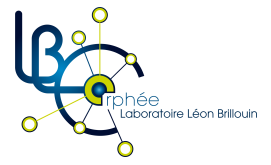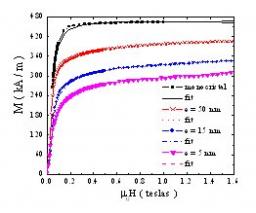Laboratoire Léon Brillouin
UMR12 CEA-CNRS, Bât. 563 CEA Saclay
91191 Gif sur Yvette Cedex, France
+33-169085241 llb-sec@cea.fr
Effect of the antiphase boundaries on the magnetic behavior in epitaxial Fe3O4(111) thin films


Dark field transmission electronic microscopy images showing the evolution of the density of antiphase boundaries (black features) according to the thickness (t) of Fe3O4 films (coll: C Gatel and E Snoeck, Cemes-CNRS).
Magnetite Fe3O4 is one of only half-metallic materials (conductor for one spin direction and insulating for the other one) to have a Curie temperature (Tc = 860 K) above the room temperature. For this reason, this ferrimagnetic oxide constitutes a material of choice for applications in spin electronics devices (magnetoresistive read heads, nonvolatile MRAM memories). These properties make it possible to predict significant tunnel magneto-resistance (TMR) effects at room temperature if one uses this oxide as electrode in a magnetic tunnel junction (JTM).
Obtaining strong TMR effects passes nevertheless by the understanding of the electronic and magnetic properties of the Fe3O4 thin films which are very different from those of bulk material. In particular magnetic measurements show that the magnetization of thin films at high field is considerably reduced compared to that of a monocrystal and that it is impossible to obtain saturation even with strong magnetic field. The presence of antiphase boundaries (APBs), structural defect present only in thin films, could be at the origin of these behaviors.
This is why we undertook to study the role of the antiphase boundaries on the magnetic properties of Fe3O4thin films. For this, thin films of Fe3O4 were worked out by molecular beam epitaxy (MBE) assisted by monoatomic oxygen plasma. The structural studies show the perfect epitaxy of the layers. Nevertheless the transmission electronic microscopy analyses reveal also the existence of antiphase booundaries, of which we could vary the density with the film thickness.
The magnetic properties, obtained by reflectometry of polarized neutrons (LLB) and by vibrating sample magnetometry (SPCSI), were studied according to the density of APBs. A model using the analogy between magnetic Bloch walls and antiphase boundaries makes it possible to interpret these measurements. In particular the virgin magnetization curves of thin films were reproduced perfectly. Thus, the disturbance brought by APBs on the magnetic behavior of thin films of Fe3O4 was clearly highlighted Phys. Rev B < b>70 (2004)174448.
#481 - Last update : 07/13 2005
•  Future optics and electronics › Nanomagnetism, spintronic and multiferroic materials
Future optics and electronics › Nanomagnetism, spintronic and multiferroic materials
• Laboratory of Physics and Chemistry of Surfaces and Interfaces




